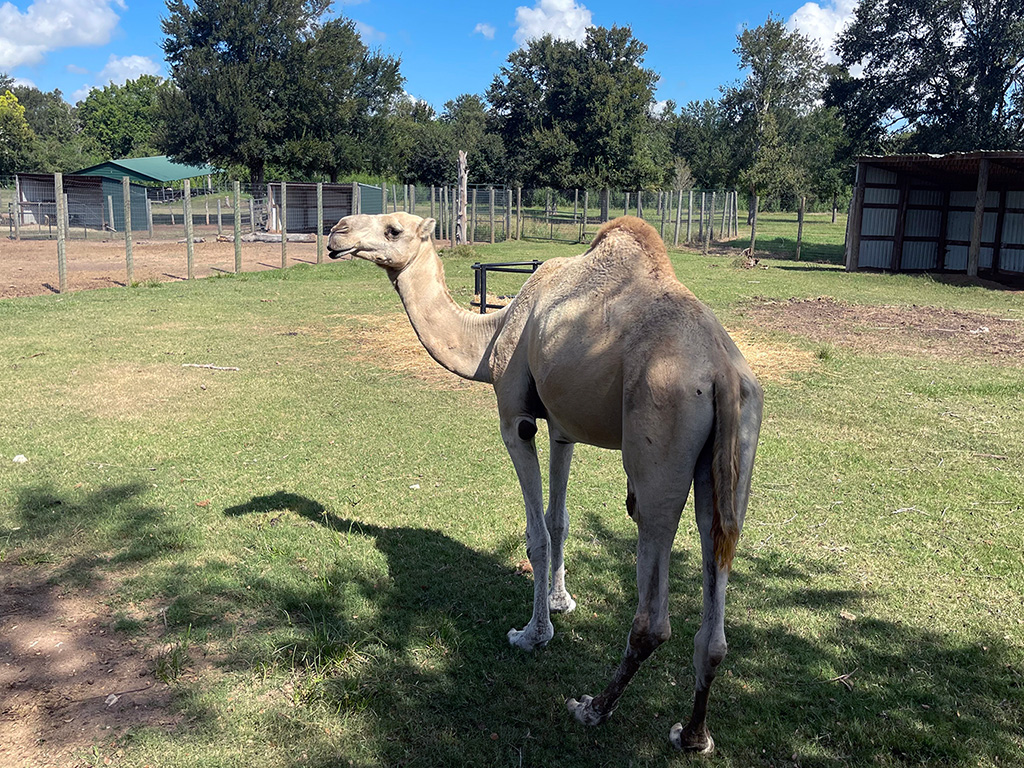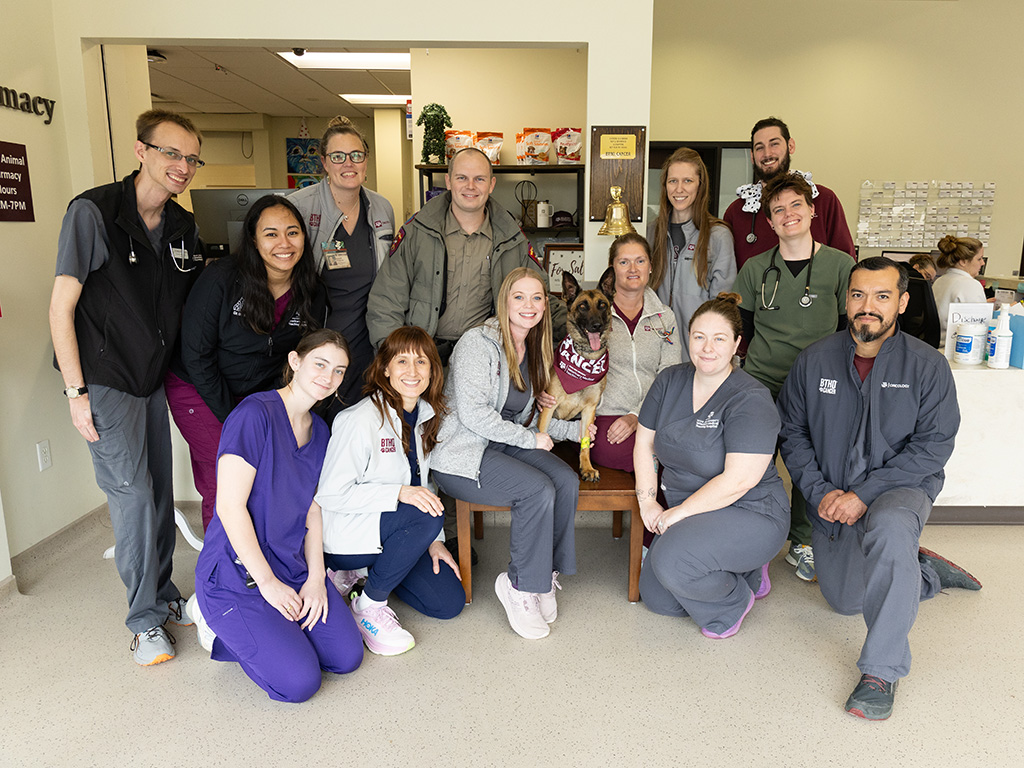Something To Smile About: Texas A&M Veterinarians Heal Camel With Dental Abscess
Story by Rachel Knight, VMBS Marketing & Communications

As a camel, Karl Humphrey spends his days living a blissful life with his brother Johnny at Blessington Farms, a family-friendly farm experience west of Houston. The dromedaries, or single-humped camels, help educate elementary children, families, and farm visitors about camels and the care they require.
Perhaps Karl’s favorite part of the job is providing guests with the opportunity for hands-on experience with camels, often through feeding lettuce to him and his brother.
“They’re very friendly, and people enjoy getting to interact with the boys by feeding them lettuce,” said Lynne Johnson, owner of Blessington Farms. “I tell people Karl and Johnny are bottomless-pit lettuce eaters!”
But when Karl’s caretakers noticed that he seemed to be losing his appetite for both lettuce and the rest of his diet, and that his jaw was swelling on one side, they knew he needed help from the Texas A&M College of Veterinary Medicine & Biomedical Sciences.
An Aggie Veterinary Tradition
Karl and Johnny are longtime patients of the Texas A&M Large Animal Teaching Hospital (LATH).
“Karl and Johnny joined Blessington Farms pretty early on,” Johnson said. “We started out as a pick-your-own berries farm, but we started bringing animals to the experience to help educate children about animals they probably don’t see every day, like camels. So, the boys came to us when they were just babies. We were still bottle feeding them when they joined the family.
“We started working with the veterinary team at Texas A&M when the boys were young,” Johnson said. “We’ve had the field service team come out since they were little for their routine veterinary care, so we’re big fans of the Aggie veterinarians.”
Over the years, it became a Blessington Farms tradition to call Texas A&M when its animals needed their regular preventative care and more specialized veterinary attention.
“Texas A&M’s veterinary services are top-notch,” Johnson said. “Everyone we’ve dealt with has been so service-oriented and so professional and has gone above and beyond to help us and our animals.”
Getting To The Root Of The Problem
Because of Blessington Farm’s tradition of working with Texas A&M veterinarians to support their animals, they knew who to call when Karl started showing signs of a dental problem in 2020.
“He wasn’t eating as much, and his face was swollen on one side,” Johnson recalled. “So, we took him to Texas A&M.”
Karl was diagnosed with a dental abscess, or a pocket of pus around the root of a tooth caused by a bacterial infection. At the time, Dr. Jennifer Schleining, a clinical professor and now head of the Department of Large Animal Clinical Sciences, assessed Karl’s infection.
Schleining determined that the infection was only affecting part of the tooth, so she performed an apicoectomy, which is a dental procedure that removes the tip of a tooth’s root to treat an infection and prevent it from spreading.
“The apicoectomy saved Karl’s tooth,” said Dr. Shannon Reed, a clinical associate professor who took over Karl’s care after Schleining assumed leadership of the department in 2022. “He was also placed on antibiotics that helped prevent future infections.”
The Heart Of The Matter

The surgery was a success, but three years later Karl became less interested in food and began losing weight again. This time, he was diagnosed with a heart murmur resulting from natural aging. At the same time Karl was diagnosed with his heart murmur, his veterinary team determined that he had another dental abscess.
“When Karl developed the heart murmur, simply removing part of the root was no longer an option,” Reed said. “Heart murmurs essentially mean that the valve on the heart is not working properly. When a person or animal with a heart murmur gets a dental infection, the infection can spread to the valve of the heart from the bacteria in the mouth. So, the risk of an infection that spreads to the heart begins to outweigh the risks associated with the very complex surgery required to remove a camel’s tooth.”
Reed knew the surgery to remove the infected tooth would be anything but easy.
“Because camel teeth have diverging roots, which means the roots wrap around and hold onto the jaw, you can’t pull them out by oral extraction,” Reed said. “You have to, instead, remove a window of the jawbone to extract the root and the tooth from the cheek. Removing a piece of a camel’s jawbone is challenging in itself, because their jaws have two walls — one on either side of the tooth. If you’re too gentle, the bone never comes off, but if you’re too aggressive, you can easily crack the other wall of the jawbone, which then requires plates and screws to repair.”
Karl’s surgery took over six hours to complete and required a team of up to eight veterinary professionals contributing to his care around the clock.
“Thankfully, we were successful in removing the tooth without fracturing his jaw,” Reed said. “We packed the socket with a putty-like material that included antibiotics to prevent another infection and took Karl to a recovery stall.”
After a few days of recovery in the LATH, Karl returned to Blessington Farms, where Johnny anxiously awaited reunion with his brother. Johnson said the siblings were thrilled to be together again, and the Blessington Farms family was excited to have Karl back home.
Life At Blessington Farms
Karl made a full recovery from his surgery and is back to helping his brother Johnny eat as much lettuce as Blessington Farms visitors can provide.
“Karl is big and beautiful, and he’s just a boss again,” Johnson said. “He’s doing really well and so is Johnny. They’re glad to be back together and all of us at Blessington Farms are happy to tell everyone how great Texas A&M and the veterinarians who work with our boys are when they visit.”
###
For more information about the Texas A&M College of Veterinary Medicine & Biomedical Sciences, please visit our website at vetmed.tamu.edu or join us on Facebook, Instagram, and Twitter.
Contact Information: Jennifer Gauntt, Director of VMBS Communications, Texas A&M College of Veterinary Medicine & Biomedical Sciences, jgauntt@cvm.tamu.edu, 979-862-4216
You May Also Like








